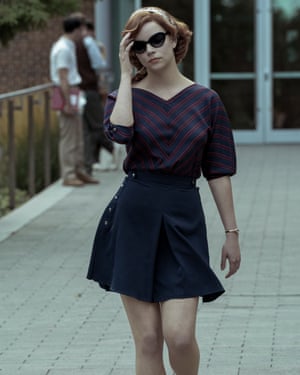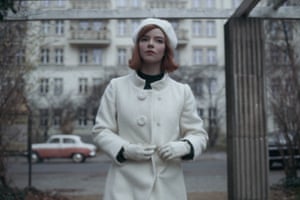In chess, the first move is everything. This is also true in TV – something The Queen’s Gambit, a seductive seven-part drama about a female chess prodigy in the American midwest, knows all too well.
In the first few moments, we meet our teenage hero, Beth Harman (Anya Taylor-Joy), asleep in a hotel bath wearing a burgundy Pierre Cardin shift dress from the night before. Moments later, she has changed into a Biba-inspired mint-green viscose one, which matches the tranquillisers she knocks back with a minibar vodka. Grabbing her shoes – black pointed flats, so this must be the 60s – she hurries downstairs to play the most important chess game of her career on the mother of all hangovers.

The Queen’s Gambit is a Netflix drama about chess and clothes, named after one of the oldest known and most aggressive opening moves in chess. Based on the 1983 novel by Walter Tevis, it is also about loneliness, addiction, the cold war and gender bias. Mainly, though, it is about the clothes. This is not reductive; it is the whole point, according to Netflix. Beth’s mid-60s costumes, designed by Gabrielle Binder (The Lives of Others) and inspired by Christian Dior and Cardin, appear alongside Princess Diana’s from The Crown in a virtual exhibition at the Brooklyn Museum in New York.
The earliest scenes of Beth feature a plucky seven-year-old orphan with a severe red bob – short, sharp, Mary Quant before Mary Quant. It sets the tone for the sort of wunderkind we are dealing with. Beth is lonely and troubled and soon becomes addicted to tranquillisers, a theme that haunts her adult years. Her main source of refuge is playing chess with the orphanage’s janitor in the building’s basement. Drawn to its predictability, something she is unable to replicate in real life, she becomes addicted to that, too. Luckily, though, she has a talent, which is noted by her adoptive mother, Alma, who agrees to accompany her on her giddy ascent to the world of professional chess championships – if she can take a 15% cut of her winnings.
Although Beth ends her reign in Moscow aged 20 as a proto-influencer – by 1968, her legions of fans have begun to dress like her – style does not come naturally to her. She enters the Kentucky orphanage wearing a pale linen dress embroidered by her mother and barely progresses beyond 50s wide skirts and scoop neck T-shirts, despite this being the 60s and her peers all wearing trousers. Yet among her opponents, men in black specs and drab grey suits (the exception being her flamboyant rival Benny Watts, who prefers robes and cowboy hats), she stands out. At the US Open in Las Vegas, she is radiant in a checkered dress with a black trim and black bolero. The semiotics, too, are glaring; her commitment to the chessboard is such that she dresses like one.

As with most of her addictions, Beth’s attachment to clothing comes from a childhood devoid of pleasure. She is bullied for what she is wearing, or rather whatshe is not – in one instance, a much-coveted pair of black and white shoes (which she finally obtains and rarely takes off). For Beth, the chessboard becomes an aesthetic form that exists on its own terms, as opposed to one that symbolises the global politics and gender tension of the US in the 60s. Chess, her clothes seem to say, is as much a lifestyle as a way of life.
Much of the show is about how she places too much value on what she wears. In Paris, she gets drunk on pastis with a model in a shift dress the night before a life-changing match. Later, she spends all her money on clothes and is unable to raise the $3,000 she needs in order to fly to a crucial tournament in the Soviet Union (for plot purposes, she finds a way). In the brittle chill of Moscow, she runs riot with her wardrobe once again – first is a scene-stealing cream-and-black checked coat with patent piping, then an all-white heavy-wool coat and matching hat, her final act as the white queen herself. (As an aside: she tends to win in white and lose in black, which mirrors the game.)
For those of us finding culture and newness almost exclusively through our TVs, The Queen’s Gambit fills the hole for stylish prestige dramas left by Mrs America, The Marvelous Mrs Maisel and, of course, Mad Men. Like politics, comedy and workplace equality, chess is not an obvious place for fashion – or for women.

But if Mrs America, for example, was an entertaining, if shallow, reading of political organising in the 70s, everything is to play for here. After all, The Queen’s Gambit is fiction. The gender gap in professional chess was – and is – painfully wide. If Beth looks splendid – sexy, even – it is because the show is not afraid to whitewash the past in order to further the plot. Only one woman, Judit Polgár, has reached the Top 10 in the World Chess Federation’s rankings.Advertisement
Still, the costumes are faithful of the period: shift dresses are borrowed from Cardin; fluted sleeve tops and short skirts inspired by Pucci and Biba; and a go-to jersey T-shirt based on one by Andre Courrèges. In a neat reflection of our video-call world, the clothes are designed to be viewed over a chessboard, because that is where the camera spends most of its time. “We wanted interesting necklines. Something that stood out, but didn’t overwhelm,” Binder told the Golden Globes last month.
Alma, who is probably depressed and almost certainly an alcoholic, is an interesting foil to Beth. A home-maker with aspirations of a brighter future, she reads the Ladies Home Journal, plucks her eyebrows and paints her nails oxblood red. Her quilted jackets and pink headpieces might appear quaint, but they do little to mask a man-hungry addict who is torn between love for Beth and financial exploitation of her talent.

Although the women are unrelated, they dress as if they are, adopting Dior’s hallmark 1947 New Look (nipped-in jackets and full skirts) – which by the 50s had trickled down to Macy’s and beyond – for their whippet-fast tours of Las Vegas, New York, Mexico and Paris. Alma even sews her own Dior-style dresses. One, an almost exact copy of an original from 1955, makes several appearances. Another, Alma’s quilted bed jacket, becomes Beth’s safety blanket. Characters repeatedly wear particular pieces – not for authenticity, but for comfort.
Read Full Story at: The Guardian